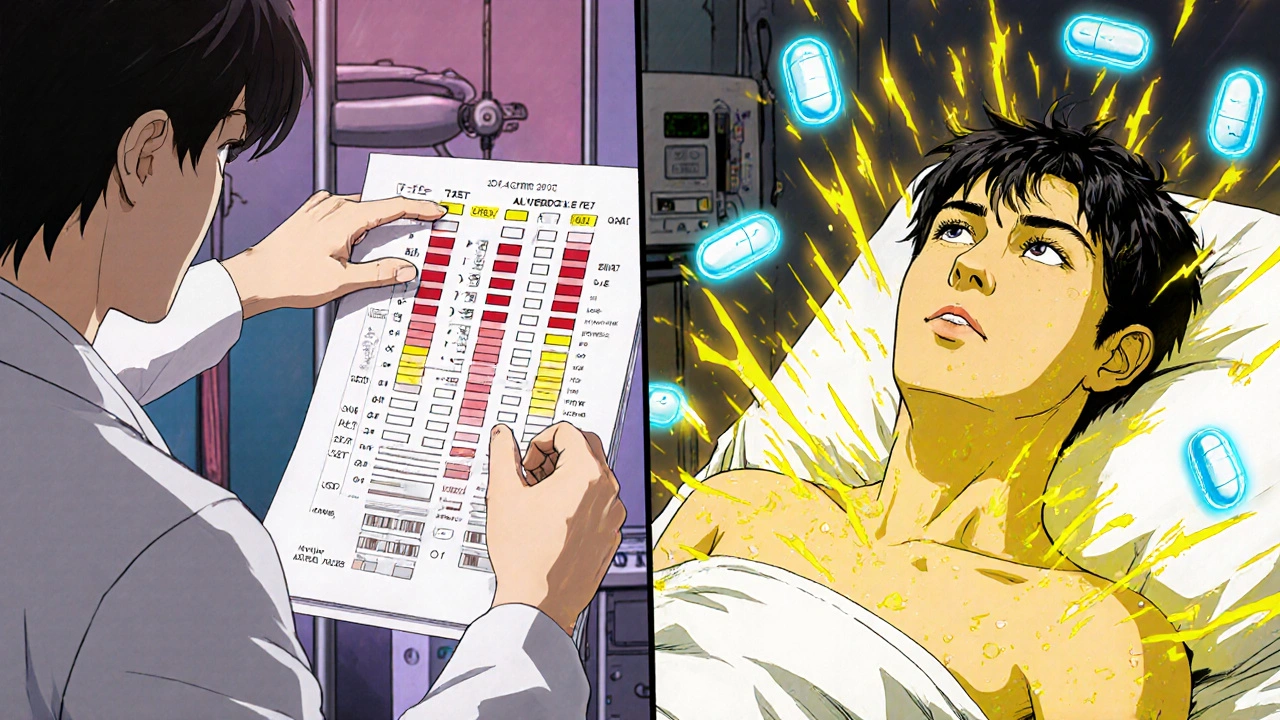When you take an antifungal for a stubborn nail infection or a systemic yeast problem, you’re trusting it to kill the fungus-not your liver. But the truth is, some of these life-saving drugs carry hidden risks that many patients and even doctors don’t fully understand. Antifungals aren’t all the same. Some are gentle. Others can wreck your liver without warning. And the worst part? You might not feel anything until it’s too late.
Not All Antifungals Are Created Equal
There are four main types of antifungals used today: polyenes like amphotericin B, azoles (fluconazole, itraconazole, voriconazole, ketoconazole), echinocandins (caspofungin, micafungin), and allylamines like terbinafine. Each works differently, and each has its own liver risk profile.Ketoconazole used to be a go-to for fungal infections. But since the FDA issued a safety alert in 2013, its use has dropped by over 90%. Why? It’s the most dangerous. About 1 in 500 people who take it develop serious liver injury. Some cases led to liver failure and transplants. The European Medicines Agency pulled it off the market entirely in 2013. Even in the U.S., it’s now only used as a last resort when nothing else works.
Voriconazole and itraconazole are next in line for risk. Data from the FDA’s adverse event system shows they cause more liver injury reports than other azoles. Voriconazole, especially, is tricky. It can spike liver enzymes between 2 to 8 weeks into treatment. If you’re on it, you need weekly blood tests-at least at first. And if you have a genetic variation in your CYP2C19 enzyme, your risk jumps 3.7 times higher. That’s not rare. About 15% of people of European or Asian descent carry this variant.
Fluconazole is the safest azole. It’s often used for yeast infections and thrush. For short courses (under two weeks), liver monitoring isn’t usually needed. But if you’re on it for months-say, for a persistent fungal lung infection-then you need regular blood tests. It’s not harmless, just less likely to hurt your liver.
Terbinafine is the go-to for toenail fungus. It’s oral, cheap, and effective. But here’s the catch: it carries a black box warning from the FDA for potential liver failure. The actual risk is low-about 0.1% of users. Still, that’s 1 in 1,000 people. Most liver issues show up within the first 6 weeks. If you start feeling unusually tired, your skin turns yellow, or you have dark urine, stop taking it and get tested immediately.
Echinocandins like micafungin and anidulafungin are given intravenously in hospitals. They’re often preferred for serious infections like candidemia because they’re less likely to interact with other drugs. But here’s the surprise: one study found anidulafungin had the highest death rate among antifungals linked to liver injury-50%. That sounds terrifying, but it’s likely because these drugs are used in very sick patients who already have failing organs. Micafungin, by contrast, has the cleanest liver safety record in this group.
How Do You Know If Your Liver Is Being Damaged?
Liver damage from antifungals doesn’t always come with screaming symptoms. Many people feel fine until their blood work shows disaster.Early signs are vague: fatigue, nausea, loss of appetite, mild stomach discomfort. Right upper quadrant pain-just under your ribs on the right side-is a red flag. Jaundice (yellow skin or eyes) means your liver is already struggling. By then, it’s often too late to reverse the damage.
Doctors rely on blood tests to catch it early. The key markers are ALT and AST (liver enzymes) and bilirubin. Normal ALT is 7-56 U/L. If it climbs above 3 times the upper limit (around 170 U/L) and you have symptoms, you should stop the drug. If it hits 5 times the limit (280 U/L) even without symptoms, it’s time to discontinue.
One patient on Reddit shared their story: after three weeks on ketoconazole, their ALT hit 1,200 U/L. Normal is 56. They ended up in the hospital. Another person on Healthline described mild jaundice at week 5 of terbinafine. They stopped the drug, and it cleared up in weeks.
These aren’t outliers. Between 2004 and 2021, the FDA recorded over 1,800 cases of liver injury tied to ketoconazole alone. That’s more than voriconazole, itraconazole, and fluconazole combined.

Drug Interactions: The Silent Killer
Antifungals don’t just hurt your liver on their own. They play dangerous games with other medications.Azoles, especially ketoconazole and itraconazole, are strong inhibitors of CYP3A4, a liver enzyme that breaks down over 50% of all prescription drugs. That means if you’re taking an antifungal and also on statins (like simvastatin), blood thinners (warfarin), or certain antidepressants, your body can’t clear those drugs properly. Levels build up. Toxicity follows.
One real-world case: a 68-year-old man on simvastatin for cholesterol started itraconazole for a fungal lung infection. Two weeks later, he developed rhabdomyolysis-muscle tissue breaking down, causing kidney failure. His simvastatin levels were 15 times higher than normal. He survived, but barely.
Ketoconazole also interferes with adrenal hormones. That’s why it’s banned for treating fungal infections in Europe. It can crash cortisol levels, leading to adrenal insufficiency. Even if your liver is fine, your body could be falling apart.
Terbinafine is safer here. It doesn’t strongly affect CYP3A4. But it can still interact with certain antidepressants like SSRIs and some heart medications. Always tell your doctor every pill you’re taking-even over-the-counter ones and supplements.
Who Needs Monitoring-and How Often?
The Infectious Diseases Society of America (IDSA) gives clear guidance: baseline liver tests before starting any systemic antifungal. No exceptions.For ketoconazole: Weekly LFTs for the first month, then every two weeks. Stop if ALT/AST exceeds 3x ULN with symptoms, or 5x ULN without.
For voriconazole: Weekly tests for the first 4 weeks. Then every 2 weeks. If you’re on it long-term, keep testing monthly. Genetic testing for CYP2C19 is now available and worth considering if you’re on it for more than a few weeks.
For itraconazole: Same as voriconazole. High risk. High vigilance.
For fluconazole: Only test if you’re on it longer than 2 weeks or have existing liver disease, alcohol use, or are elderly.
For terbinafine: Test at 4-6 weeks. If treatment goes beyond 8 weeks, test every 4-6 weeks after that. Most liver issues happen early. But not all.
For echinocandins: Test before and during treatment if you have preexisting liver disease. Micafungin is safest. Anidulafungin? Use with caution in patients with liver failure.
Here’s the scary part: a 2020 study found only 37% of primary care doctors monitoring LFTs during terbinafine therapy for nail fungus. That’s not just negligence-it’s dangerous. Patients assume their doctor’s ordering the test. Often, they’re not.

What’s Changing? The Future of Antifungal Safety
The tide is turning. Ketoconazole is fading out. Newer antifungals are being designed with liver safety as a top priority.Drugs like olorofim and ibrexafungerp are in late-stage trials. Early data shows they cause 78% fewer liver enzyme spikes than older azoles. That’s huge. If they get approved, they could replace voriconazole and itraconazole for many patients.
Genetic testing is becoming more accessible. If you’re prescribed voriconazole, a simple blood test can tell you if you’re genetically prone to liver damage. That’s precision medicine in action.
The FDA’s Sentinel Initiative now tracks antifungal liver injury in real time across millions of patient records. AI algorithms are being trained to spot warning signs before they become crises. These aren’t futuristic ideas-they’re happening now.
But here’s the bottom line: until these new drugs are widely available, the old ones are still in use. And they still carry real risk.
What Should You Do?
If you’re prescribed an antifungal:- Ask: “Which one are you prescribing, and why?” Don’t accept “it’s the usual.”
- Ask: “Do I need liver tests? When? How often?” Get it in writing.
- Ask: “What other meds or supplements am I taking that could interact?” Bring your pill bottle.
- Know the warning signs: fatigue, nausea, yellow skin, dark urine, right-side pain.
- Don’t ignore mild symptoms. They’re your body’s first alarm.
- If you’re on terbinafine for nail fungus, don’t assume it’s “safe.” Get tested at week 6.
- If you’re on ketoconazole, stop immediately and talk to your doctor. It’s not worth the risk.
Antifungals save lives. But they can also end them. The difference isn’t luck. It’s awareness. It’s asking questions. It’s demanding blood tests. It’s refusing to let a simple fungal infection cost you your liver.
Can antifungals cause permanent liver damage?
Yes, in rare cases. Drugs like ketoconazole and voriconazole have caused acute liver failure requiring transplant. Most people recover fully if the drug is stopped early and liver damage is caught before it’s severe. But if injury progresses to cirrhosis or liver failure, the damage can be permanent. Early detection through blood tests is the best defense.
Is terbinafine safe for long-term use?
Terbinafine is generally safe for short courses (6-12 weeks for nail fungus), but long-term use increases liver risk. The FDA recommends liver enzyme testing at 4-6 weeks and then every 4-6 weeks if treatment extends beyond 8 weeks. If you’re on it for months, monitor closely. Most liver issues occur within the first 2 months.
Why is ketoconazole still available if it’s so dangerous?
The FDA restricted ketoconazole to second-line use only-for rare, life-threatening fungal infections like histoplasmosis or coccidioidomycosis-when other drugs don’t work or aren’t available. It’s no longer approved for skin, nail, or vaginal infections. Its use has dropped over 90% since 2013. Many doctors won’t prescribe it at all.
Do over-the-counter antifungals affect the liver?
Topical antifungals-creams, sprays, powders for athlete’s foot or ringworm-don’t enter the bloodstream in significant amounts, so they don’t harm the liver. Only oral or intravenous antifungals carry this risk. Never assume a pill labeled “natural” or “herbal” is safe. Some supplements contain hidden antifungals that can cause liver injury.
Can I drink alcohol while taking antifungals?
No. Alcohol increases liver stress and can worsen antifungal-induced liver injury. The FDA specifically warns against alcohol with ketoconazole. But even with safer antifungals like fluconazole or terbinafine, alcohol raises your risk of liver damage. Avoid it entirely while on treatment and for at least a week after stopping.
What should I do if my liver tests come back abnormal?
Don’t panic. First, confirm the result with a repeat test. If levels are still high, contact your prescribing doctor immediately. Do not stop the medication without medical advice-some infections can worsen quickly. Your doctor may pause the drug, switch you to a safer alternative, or refer you to a liver specialist. Never ignore elevated liver enzymes.

